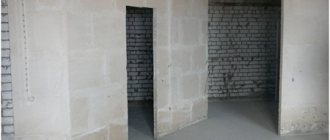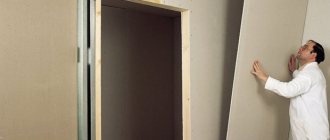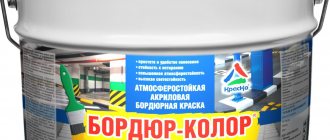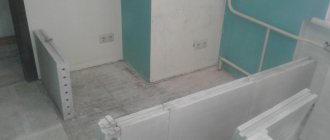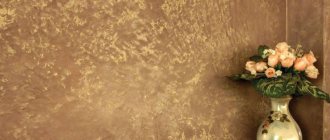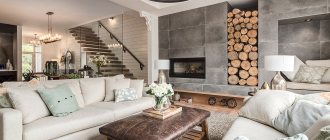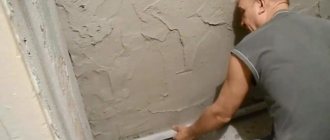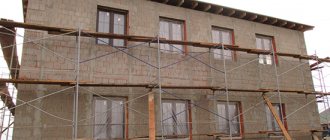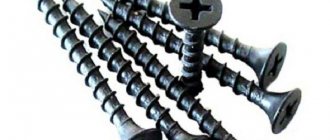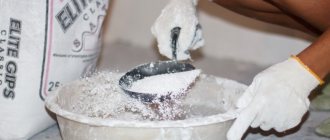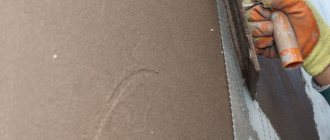What are tongue-and-groove slabs
The tongue-and-groove connection was invented a long time ago. Many people know it from lining (when the boards are joined using protrusions and grooves). The developers of the new material for partitions, having chosen the rectangular shape of slab blocks 8-10 cm thick, decided to use this connection to fix the blocks to each other along the entire perimeter.
Tongue-and-groove rectangles, when connected, form a “canvas” with smooth flat surfaces. This design significantly speeds up the folding of partitions, without requiring the construction of a frame (which is needed, for example, for drywall). Installation is carried out using tile adhesive or mounting mixture.
Pgp can be:
- gypsum;
- silicate.
Gypsum plasterboards are made by casting from a gypsum solution with plasticizing additives. The products are quite durable, since gypsum grades no lower than 4 are used for their production.
Gypsum is known for its ability to form small pores through which the material breathes (gas and moisture exchange with the surrounding space). Therefore, pgp are environmentally friendly and contribute to the comfort of living. The blocks are non-flammable, durable, and repairable.
Since gypsum “dislikes” excess water, pgp is produced with the addition of moisture-repellent additives to gypsum raw materials. Such products, which have a greenish tint, are used for rooms with high humidity. They produce solid and hollow slabs that weigh less.
To make silicate tongue-and-groove slabs, quicklime is mixed with water and quartz sand. After molding by pressing, the mixture is subjected to high-temperature treatment in an autoclave chamber.
Such products are stronger than gypsum, they are even used for load-bearing walls between rooms. Durable lime-sand conglomerate is less susceptible to dampness, which is why silicate sandstones are used when constructing partitions in bathrooms and other damp rooms. The weight of these products is higher.
Advice from experienced repairmen
Here are some tips to help you install walls to the highest quality:
- “Many sources contain information that a slab partition can be installed in one day. It is not right. It’s best to let the first layer “settle” for a day, and then continue working.” Zoya makes repairs with her own hands.
- “Although they say that work with tongue-and-groove blocks is carried out practically without dirt and dust, this is not entirely true. The process of sawing slabs is quite dusty, so you should be prepared for constant cleaning.” Oleg, a novice repairman.
- “The material is quite new for our market, but already popular. I liked it not only for the smoothness of the surface, but also for the ease of installation. I only hung shelves and a TV on the finished wall, but I didn’t dare to put cabinets,” Dmitry, renovating his dacha.
At first glance, partitions made from tongue-and-groove blocks are an ideal option for constructing walls and zoning space. However, such material must also have its drawbacks. Information on ways to solve problems that arise during installation and operation would be helpful. Share your experience with us!
Installation of PGP is carried out strictly in rows, starting from the bottom. The first row is basic and must be correctly oriented in space, vertically and horizontally. The most common error during installation is “waviness” of the partition, which occurs due to a slight displacement in the grooves. To eliminate this phenomenon, when laying each slab, you need to use a rule strip and check the general plane of the partition against it.
The first row should be laid from the corner. The area where the slab touches the floor and wall is covered with GGP glue, then the block is installed with the ridge up and its position is leveled. It is convenient to use a rubber mallet to move the slabs. Be sure to fasten the first block to the wall and floor using L-shaped plates, the role of which is successfully performed by direct hangers. To use them, you need to cut off the toothed comb from the edges and bring the thickness of the plate to the width of the comb. The plates are first attached to the base using quick-installation dowels with a length of 80 mm or more, then to the slab with black self-tapping screws no less than 60 mm long.
Subsequently, the slabs are attached through one side: on one side to the floor, on the other - to the previous slab, with a preliminary coating of the joint with a thin layer of glue and strong pressing. To control the placement of slabs according to the project, it is convenient to use lacing or a laser level. It would also be a good idea to mark the partition on the floor and walls indicating the locations for the doorways.
In what cases is it necessary to plaster tongue-and-groove slabs?
By performing the installation correctly, they achieve an almost flat surface with seams up to 2 mm. Such partitions do not need leveling, and for finishing, the resulting “canvas” is puttied by applying a thin layer of putty. A smooth surface does not require plastering before tiling the partition.
Plaster will be needed if:
- the finishing touch will be painting or pasting with light, thin wallpaper (putty is used);
- if the base of the first row was made poorly, which resulted in uneven folding of the parts;
- if the building is expected to shrink, and it is also necessary to prevent the appearance of cracks when the building is displaced relative to neighboring ones (reinforcement is required).
Often, newbies are taken on the task of “assembly” and do not succeed in everything the first time. In some cases, locally (even on a flat surface), it is necessary to thicken the partition for structural or aesthetic reasons. Then plastering tongue-and-groove slabs is a necessary task, so we are further considering this option.
Choosing putty: three options for an important decision
How will the walls and ceilings look in the interior? The right choice of wallpaper and paint is not the only condition for a beautiful appearance. An equally important role is played by high-quality preparation of the surface on which the finishing coating is applied.
Each decorative coating has its own requirements for surface preparation. For example, for ceramic tiles it is enough to smooth out the most noticeable unevenness of the walls, but for thin wallpaper, decorative plaster, and especially paint, a perfectly smooth base is required. To achieve this result, special putty mixtures are used.
We will figure out what they are and how they differ together with KNAUF.
What types of putty are there?
Three types of putties are mainly used in construction: cement, gypsum and polymer. The classification is based on the type of binder, which, as you already understand, includes gypsum, cement or polymer compounds. The other two components in the putty are a filler, which is usually powdered marble, limestone or chalk, as well as modifying additives that improve and regulate the properties of the solution.
After mixing with water and mixing, the dry putty mixture acquires a paste-like consistency, and in this form is applied to the base in a thin layer, hiding unevenness. After drying, the composition hardens, firmly adhering to the surface.
How to plaster tongue-and-groove slabs
The choice of plaster is determined, first of all, by the properties of the material. Gypsum is characterized by less strength than concrete or brick. Therefore, it is not recommended to load gypsum boards with a plaster layer of heavy mortars, such as cement-sand. Based on another property of gypsum - its conflicting “relationship” with cement, plastering with cement-based mixtures is also impossible.
What remains are gypsum or lime compounds. It is more rational to use the former. Gypsum solutions form a coating that is light, quick-drying, plastic, and has the same linear expansion coefficient as gypsum-based coatings. When applied correctly, such compositions form a smooth surface that can be painted without puttying.
The situation is different with silicate gps. They can be plastered with mineral compounds based on gypsum or cement. Plastering with lime-cement plasters or lime-gypsum mortars is possible.
Tools and materials
Puttying walls requires the presence of tools and devices, without which high-quality work is impossible:
- A drill or hammer drill with a special mixer attachment for preparing putty. The device will help achieve a homogeneous, uniform composition.
Figure 2. Drill with attachment.
It is almost impossible to make a putty solution from dry mixtures without using a mixer, so if you don’t have one, buy putty in the form of a ready-made paste.
- A container in which we will stir the mixture. It is good to use round-shaped construction basins made of impact-resistant plastic for this. They are easy to clean, convenient to mix the solution and collect the mixture.
Figure 3. Construction basin.
- Rule for leveling thick layers of putty in case of significant deviations.
Figure 4. Rule.
- Spatulas with a width of 300 and 100 millimeters for distributing and leveling putty. Choose a tool with a perfectly straight blade and a comfortable handle.
Figure 5. Wide spatula.
Important!
A wide spatula is the main tool when applying putty. Choose it in a higher price segment, because the ease of application and the quality of the putty surface depend on the evenness and reliability of the blade.
- Special profile spatulas for finishing internal and external corners.
How to plaster tongue-and-groove blocks
With the exception of the limitation on the type of base plaster composition, the technology for plastering walls differs little from the usual one. If the walls are smooth, the layer thickness is small. This means that beacons are not required for plastering work. When the coating thickness is more than 10 mm, beacons are used.
Since good adhesion is ensured by other measures, it is not necessary to apply a spray coat. Plastering is done in one layer. If the thickness exceeds 3 cm, install reinforcing plastic or fiberglass mesh on flat areas, and reinforce the corners with perforated corners with mesh.
After applying the solution to the base, level it using the rule. After waiting until the solution sets (about 40 minutes), it is cut with a sharp edge of the rule. Be sure to remove the beacons when the plaster mixture dries.
The resulting grooves are filled with gypsum mixture, leveling over the hardened plastered surface of the areas adjacent to the grooves using a wide spatula.
If a smooth surface is required for painting, the top of the plaster is leveled with stainless spatulas or sanded. You can also putty the surface.
Putty Knauf solutions for starting and finishing surface treatment
A variety of Knauf putty options are available to the buyer - for working with walls, indoors and outside the building. The manufacturer offers cement, gypsum, dispersion, and mineral putty.
- Why do you need different putty?
- Characteristics and properties of putty
- What does the starting putty offer, what are its properties?
- What is Rotband, pasta and Profi
- Finishing putty and multi-finish
- Features of using putty
Why do you need different putty?
The difference between the mixtures is expressed:
- The use of mixtures in rooms with different temperatures and humidity levels;
- For work at the initial or finishing stage;
- Certain types of putty are relevant for sealing seams;
- Purchasing types convenient for construction/repair or finishing/cosmetic work.
In addition to the finishing or starting putty used during the repair process, cement putty is also used, which is relevant during construction. It is the best material for eliminating chips, cracks and unevenness.
Characteristics and properties of putty
The advantages of this building material include strength and durability. After the putty dries, no cracks appear on the surface. The thickness of the layer, which varies over a wide range, is also relevant, due to which the putty is used in any type of work.
Another plus is low consumption. The buyer will save money when purchasing building materials, and the work time will be reduced.
Starter putty is available for purchase, used in the initial stages of repair, or pro putty is universal. At the end of the work, a finishing or less common, but effective - multi-finish is used.
To achieve goals, the buyer is offered Rotband or paste.
Putty Rotband Knauf
What does the starting putty offer, what are its properties?
This putty is a mixture consisting of gypsum and lime. It is used for interior decoration of rooms in the house in which humidity is constantly maintained within normal limits. Starter putty is also applicable for other types of premises from commercial/office to industrial.
Often this type of putty is used for repair, restoration or construction work in hospitals and hotels.
The purpose of the starting putty is to level the surface before applying subsequent layers, be it finishing putty or other decorative coating.
Starter putty is popular because it is able to regulate the humidity conditions in the room, hides defects in the walls, including cracks or problem areas, and prepares the wall for applying the next layer. It is safe for humans - environmentally friendly and will not harm the health or life of people in the room on the walls of which Knauf putty is applied.
This building material is used in the early stages of renovation. With its help, primary surface problems are eliminated. After drying, the starting putty becomes a surface on which it is convenient to work later, using other building materials, including finishing putty or decorative coating.
The Knauf starter version is offered to the buyer in different weights (packages weighing from 5 kg), so choosing the required quantity for any task is not difficult.
Features of pgp plaster in wet rooms
When preparing to renovate a bathroom or other rooms where high humidity is expected, all materials and technological methods are selected based on these conditions:
- type pgp (moisture resistant), primers;
- types of putty or plaster with hydrophobic properties;
- finishing materials that are not afraid of water exposure;
- installation of a waterproofing layer, etc.
For such premises, as a rule, either silicate or gypsum waterproof tongue-and-groove blocks are chosen. In places where there is no contact of gypsum boards with water, you can limit yourself to priming the surface.
But where contact is possible, technologists recommend applying waterproofing agents over the primer. It is also necessary to cut off the penetration and rise of water from the bottom of the partition by using waterproofing tape and applying one or two layers of waterproofing to the bottom of the wall. You may find the article useful about whether it is possible to lay tiles on gypsum plaster.
The classic option for protecting tongue-and-groove slabs is two layers of deep penetration primer + a polymer-based coating primer.
About plastering
To answer the question of whether tongue-and-groove slabs need to be plastered, let’s remember what plastering is. This is the process of rough finishing of building surfaces to correct misalignments, deviations from the vertical and other irregularities of more than 30-50 mm. Correction of smaller deviations up to 10 mm is called puttying. Each process uses its own building mixtures. Read: How to plaster drywall.
It is worth noting that modern plaster mixtures make it possible to minimize the plaster layer and reduce its thickness to 5 mm.
Types of adhesives
of adhesive foam for GGP in terms of performance: regular and frost-resistant . The first is used in apartments and private houses where heating is available and the air temperature does not reach critical levels. Frost-resistant adhesive is used to create partitions in production facilities, warehouses, and industrial halls. It contains special protective components that allow the slabs to withstand frosts down to -15 degrees without losing their strength properties.
CJSC "Samara Gypsum Plant"
alt=”Samara Gypsum Plant” width=”250″ height=”89″ />The enterprise is deservedly one of the largest in the gypsum industry. Operating since 1944, in Soviet times it was a leader in its field, producing a record number of products. Today the plant offers dry construction mixtures and gypsum products, which are used in 13 different industries and exported to neighboring markets.
In 2003, the production of tongue-and-groove slabs was mastered and since then their range has been constantly expanding. The company produces small-sized (600*300 mm) and standard (667*500 mm) tongue-and-groove slabs . Conventional and moisture-resistant slabs with a thickness of 80 and 100 mm are presented. High quality and a large selection of products ensure a consistently high demand for the company's products.
